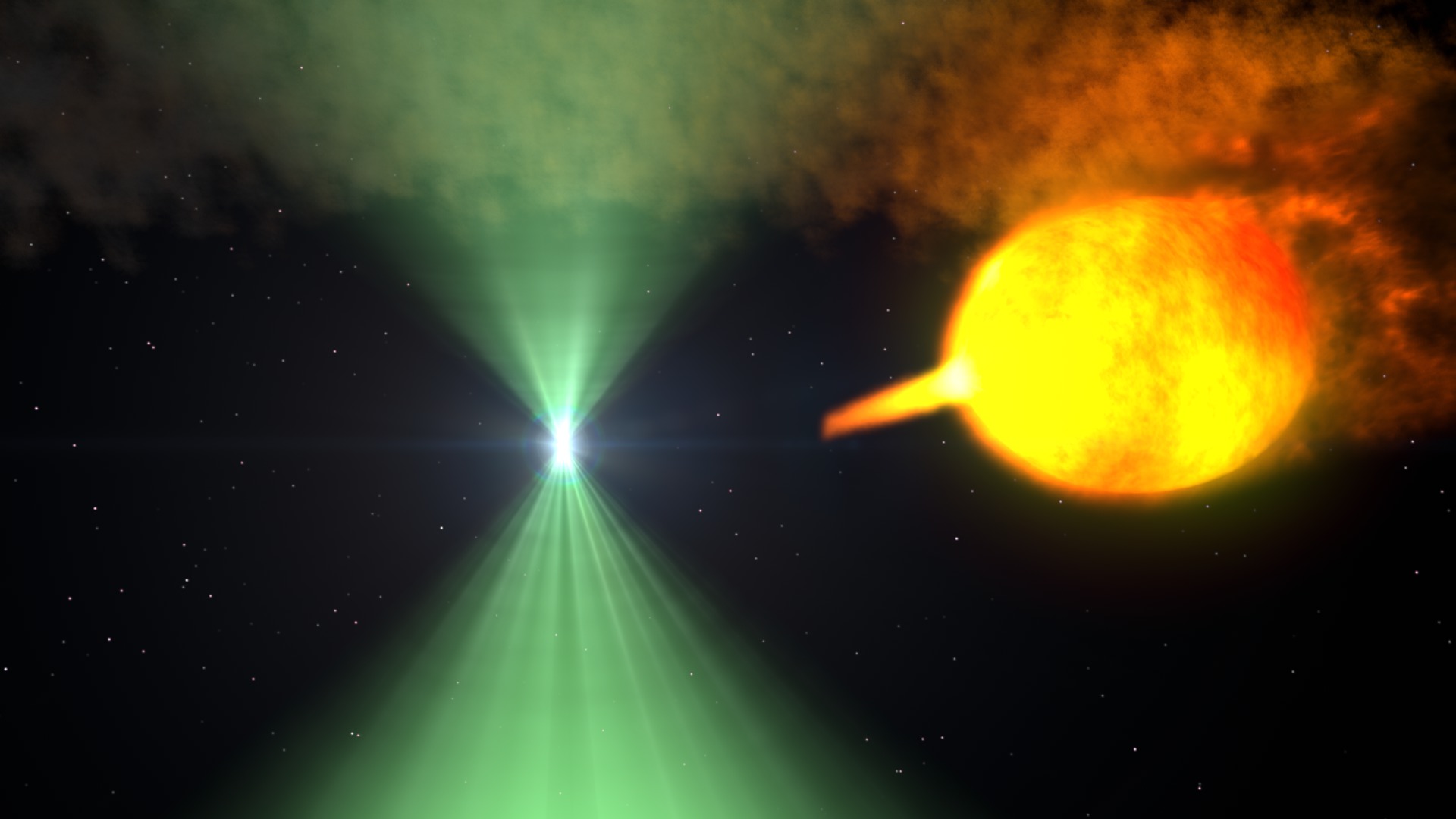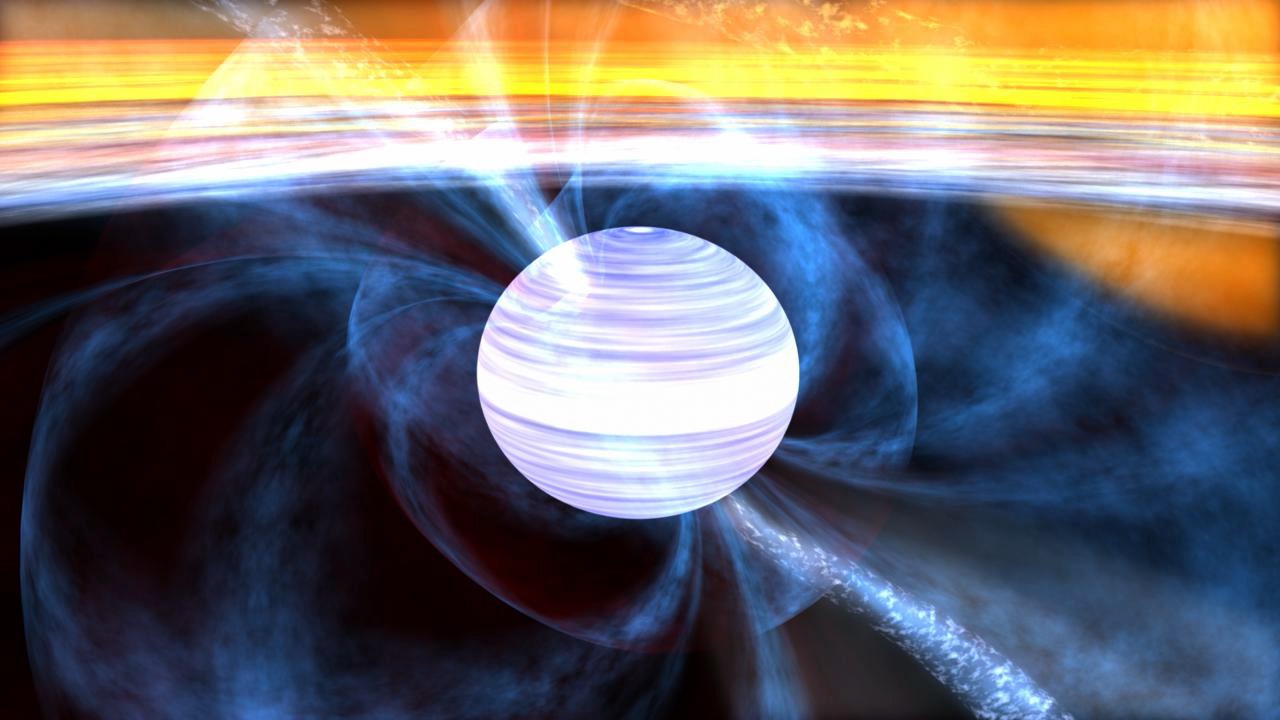NASA's Fermi Catches a 'Transformer' Pulsar
In late June 2013, an exceptional binary system containing a rapidly spinning neutron star underwent a dramatic change in behavior never before observed. The pulsar's radio beacon vanished, while at the same time the system brightened fivefold in gamma rays, the most powerful form of light, according to measurements by NASA's Fermi Gamma-ray Space Telescope.
The system, known as AY Sextantis, is located about 4,400 light-years away in the constellation Sextans. It pairs a 1.7-millisecond pulsar named PSR J1023+0038 — J1023 for short — with a star containing about one-fifth the mass of the sun. The stars complete an orbit in only 4.8 hours, which places them so close together that the pulsar will gradually evaporate its companion.
To better understand J1023's spin and orbital evolution, the system was routinely monitored in radio. These observations revealed that the pulsar's radio signal had turned off and prompted the search for an associated change in its gamma-ray properties.
What's happening, astronomers say, are the last sputtering throes of the pulsar spin-up process. Researchers regard the system as a unique laboratory for understanding how millisecond pulsars form and for studying details of how accretion takes place on neutron stars.
In J1023, the stars are close enough that a stream of gas flows from the sun-like star toward the pulsar. The pulsar's rapid rotation and intense magnetic field are responsible for both the radio beam and its powerful pulsar wind. When the radio beam is detectable, the pulsar wind holds back the companion's gas stream, preventing it from approaching too closely.
But now and then the stream surges, pushing its way closer to the pulsar and establishing an accretion disk. When gas from the disk falls to an altitude of about 50 miles (80 km), processes involved in creating the radio beam are either shut down or, more likely, obscured. Some of the gas may be accelerated outward at nearly the speed of light, forming dual particle jets firing in opposite directions. Shock waves within and along the periphery of these jets are a likely source of the bright gamma-ray emission detected by Fermi.
Narrated video. Zoom into an artist's rendering of AY Sextantis, a binary star system whose pulsar switched from radio emissions to high-energy gamma rays in 2013. This transition likely means the pulsar's spin-up process is nearing its end.
Credit: NASA's Goddard Space Flight Center
Watch this video on the NASA Goddard YouTube channel.
For complete transcript, click here.

These artist's renderings show one model of pulsar J1023 before (top) and after (bottom) its radio beacon (green) vanished. Normally, the pulsar's wind staves off the companion's gas stream. When the stream surges, an accretion disk forms and gamma-ray particle jets (magenta) obscure the radio beam.
Credit: NASA's Goddard Space Flight Center

This artist's rendering shows one model of pulsar J1023 before its radio emission (green) vanished. Normally, an outflow of high-energy particles from the pulsar staves off the gas stream from its companion.
Credit: NASA's Goddard Space Flight Center

This artist's rendering shows one model of pulsar J1023 after its radio emission vanished. When the companion's gas stream surges, the stronger flow pushes through the pulsar wind and establishes an accretion disk. This fuels the development of relativistic particle jets that produce gamma rays (magenta).
Credit: NASA's Goddard Space Flight Center
This animated gif of the artist's rendering shows one model of pulsar J1023 as its radio emission vanishes. When the companion's gas stream surges, the stronger flow pushes through the pulsar wind and establishes an accretion disk. This fuels the development of relativistic particle jets that produce gamma rays (magenta).
Credit: NASA's Goddard Space Flight Center
For More Information
Credits
Please give credit for this item to:
NASA's Goddard Space Flight Center. However, individual items should be credited as indicated above.
-
Animator
- Cruz deWilde (Avant Gravity)
-
Video editor
- Scott Wiessinger (USRA)
-
Narrator
- Scott Wiessinger (USRA)
-
Producer
- Scott Wiessinger (USRA)
-
Scientist
- Anne Archibald (ASTRON)
-
Writer
- Francis Reddy (Syneren Technologies)
Missions
This page is related to the following missions:Series
This page can be found in the following series:Tapes
The media on this page originally appeared on the following tapes:-
Transformer Pulsar
(ID: 2014055)
Thursday, July 10, 2014 at 4:00AM
Produced by - Robert Crippen (NASA)
Release date
This page was originally published on Tuesday, July 22, 2014.
This page was last updated on Wednesday, May 3, 2023 at 1:50 PM EDT.


